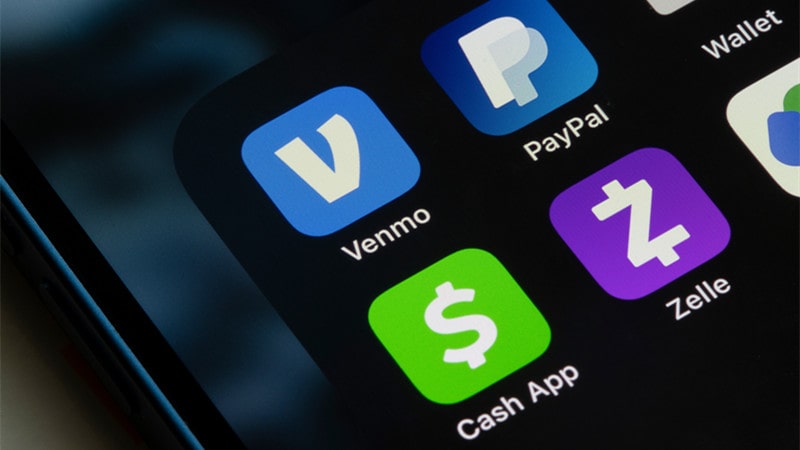
With the sharp rise in internet access, online banking transformed traditional finance. In 2018, about 61% of Americans used digital banking. Projections suggested that the figure might rise to above 65% by 2022.
The numbers smashed that forecast by a wide margin. An estimated 80% of Americans preferred digital banking, as of 2022, via a website or mobile app.
Electronic peer-to-peer (P2P) payment systems became popular with the founding of PayPal in 1998. Over a decade later, in 2013, PayPal bought Venmo, a smaller P2P company that founded the well-known mobile app in 2009.
Cash App, a rival, came onto the scene around the same time.
Here’s a look at Cash App vs. Venmo for P2P payments and other digital transactions.
Rise of Venmo for Digital P2P Payments
Entrepreneurs Andrew Kortina and Iqram Magdon-Ismail founded Venmo in 2009 to exchange money through a Short Message System (SMS). They privately launched their mobile app a year later.
Users could send and withdraw money by connecting a credit or debit card to the app.
Originally designed as a way for musicians to sell songs and merchandise and students to buy food at food trucks, Venmo would become a significant cultural phenomenon.
The social aspect of sending and receiving money between other Venmo users appealed to millions of iOS and Android users.
Who Owns Venmo?
A few months after Venmo’s public launch, Braintree—a mobile and web payment platform for e-commerce businesses—bought Venmo for over $26 million.
In 2013, PayPal paid $800 million for Braintree, which included Venmo. They eliminated transaction costs, allowing free payment transfers between users.
Venmo generates revenue by charging businesses 2.9% on transactions. There’s also a 1% fee for withdrawals.
Top banks in the U.S. launched Zelle in 2017 as a competitor to Venmo. However, as of 2022, Venmo’s market share stood at 52.5% of all P2P payment users in the country.
Venmo maintains over 78 million users worldwide, processing $244 billion in payments in 2022. The company generated nearly $1 billion in annual revenue, a 10% increase from 2021.
With the success of Venmo, there’s prominent competition among a rival like Cash App.
How Does Cash App Compare to Venmo?
With a revolutionary appeal boosting Venmo into becoming a verb in the English language, entrepreneur Jack Dorsey likely followed the app’s success. As one of the founders of Twitter (now “X”) in 2006, Dorsey co-founded Square, Inc. in 2019.
Square sought to provide point-of-sale systems to businesses in the U.S., Canada, Australia, and elsewhere as a fintech company.
Available to users in the U.S. and U.K., Square (which rebranded to Block, Inc. in 2021) launched Cash App in 2013.
The app charges a 1.5% fee for money transfers between users.
By 2015, “Square Cash” allowed users to create a unique $cashtag attached to their accounts.
As a proponent of Bitcoin, Dorsey’s Cash App allowed users to buy and sell the popular crypto in 2018. In the following year, users could participate in trading stocks through the app.
Today, there are even gambling sites that take Cash App.
Venmo Financial Statistics
Block launched its Cash App around the time PayPal bought Venmo. It took a few years for both apps to catch on noticeably.
Venmo’s ability to handle a total payment volume of $2.3 billion in 2014 increased by more than 100 times in eight years. Their annual users doubled from five to ten million between 2016 and 2017.
Between 2017 and 2022, Venmo’s annual revenue increased by nearly 6,000%. By 2022, they’d reached almost 80 million users.
Valued at $100 million in 2013, the company generated a valuation of $38 billion in 2020, a staggering increase of 38,000%.
Venmo led the P2P payment system as a PayPal subsidiary in stiff competition against Block and Cash App.
Cash App Financial Statistics
Within a few years of launching, Cash App began allowing users to maintain a balance in 2016 to help generate revenue. They established their Cash Card in 2017 to entice new users.
Their big step forward, however, came from allowing Bitcoin transactions in 2018.
Cash App went from three million users in 2016 to 51 million by 2022. The app’s annual revenue increased to nearly $11 billion, up from $400 million in 2018.
With revenue soaring to $12.3 billion in 2021, about $10 billion came from Bitcoin transactions.
The company generated $2.07 billion in profit in 2021 and almost $3 billion the following year. Eighteen million users possess a Cash App Card as of 2022.
As competitors, Venmo and Square generated similar payment volumes in 2018. After three years of pulling ahead, Venmo came in around $200 billion in 2022, only $13 billion more than Square.
Is Venmo Better Than Cash App?
The main features of Block’s Cash App include banking, a customizable Cash Card, and P2P transfers ($cashtag and QR codes). Bitcoin trading, however, comprises a vast majority of the company’s revenue.
Cash App users may also trade stocks directly on the app.
Like PayPal, Venmo allows users to buy Bitcoin, Ethereum, Litecoin, and Bitcoin Cash. To trade stocks, Venmo users can deposit money on a stock trading platform.
Significant differences between Venmo and Cash App include security, spending limits, and customer support.
Choosing between the two may depend on personal preferences.
Why not try both and see which one suits you best?








